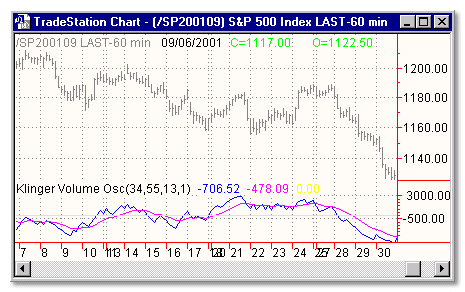Download: kvo.ela
File Includes:
Indicator - Klinger Volume Osc
Function - KVO
Function - VForce
Category: Indicator > Volume Based
Description:
The Klinger Oscillator (KO) was developed by Stephen J. Klinger. Learning from prior research on volume by such well-known technicians as Joseph Granville, Larry Williams, and Marc Chaikin, Mr. Klinger set out to develop a volume-based indicator to help in both short- and long-term analysis.
The KO was developed with two seemingly opposite goals in mind: to be sensitive enough to signal short-term tops and bottoms, yet accurate enough to reflect the long-term flow of money into and out of a security.
The KO is based on the following tenets:
Price range (i.e. High - Low) is a measure of movement and volume is the force behind the movement. The sum of High + Low + Close defines a trend. Accumulation occurs when today's sum is greater than the previous day's. Conversely, distribution occurs when today's sum is less than the previous day's. When the sums are equal, the existing trend is maintained.
Volume produces continuous intra-day changes in price reflecting buying and selling pressure. The KO quantifies the difference between the number of shares being accumulated and distributed each day as "volume force". A strong, rising volume force should accompany an uptrend and then gradually contract over time during the latter stages of the uptrend and the early stages of the following downtrend. This should be followed by a rising volume force reflecting some accumulation before a bottom develops.
Usage:
- The most reliable signals occur in the direction of the prevailing trend. Strict stop guidelines (i.e., failure to penetrate the zero line or a violation of the trigger line) should remain in force.
- The most important signal occurs when the KO diverges with the underlying price action, especially on new highs or new lows in overbought/oversold territory. For example, when a stock makes a new high or low for a cycle and the KO fails to confirm this, the trend may be losing momentum and nearing completion.
- If the price is in an uptrend (i.e., above an 89-day exponential moving average), buy when the KO drops to unusually low levels below zero, turns up, and crosses its trigger line. If the price is in a downtrend (i.e., below an 89-day exponential moving average), sell when the KO rises to unusually high levels above zero, turns down, and crosses its trigger line.

Inputs:
FastX - the length of the faster (shorter) exponential moving average of the volume force
SlowX - determines the length of the slower (longer) exponential moving average of the volume force
TrigLen - determines the length of the exponential moving average used to smooth the KVO line
Smooth - determines the amount of smoothing of the KVO and trigger lines using a summation of the values
Note: If the Smooth input is set to 1 or zero, no smoothing will be in effect.
EasyLanguage Code:
INPUTS: FASTX(34), SLOWX(55), TRIGLEN(13), SMOOTH(1);
VARS: TRIGGER(0);
TRIGGER = XAVERAGE(KVO(FASTX, SLOWX), TRIGLEN);
IF SMOOTH <= 1 THEN BEGIN
PLOT1(KVO(FASTX, SLOWX), "KVO");
PLOT2(TRIGGER, "KVO TRIGGER");
END ELSE BEGIN
PLOT1(SUMMATION(KVO(FASTX, SLOWX), SMOOTH), "KVO");
PLOT2(SUMMATION(TRIGGER, SMOOTH), "KVO TRIGGER");
END;
PLOT3(0, "ZERO");
IF PLOT1 CROSSES ABOVE PLOT2 OR PLOT1 CROSSES BELOW PLOT2 OR
PLOT2 CROSSES ABOVE PLOT3 OR PLOT2 CROSSES BELOW PLOT3 THEN
ALERT = TRUE;
{
COPYRIGHT C 1997, TECHNICAL ANALYSIS, INC.
}